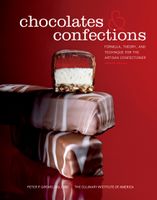🍜 Check out our Noodle bookshelf, and save 25% on ckbk Premium Membership 🍜
By Peter Greweling and Culinary Institute of America
Published 2007
Honey has a long history of use in nougats and other aerated candies. Because invert sugar is its primary sugar component, honey aids in preventing crystallization, results in a tender bite, and contributes sweetness and flavor. Due to its hygroscopicity, honey is an effective humectant, helping to prevent finished confections from drying out. While this is an advantage for high-moisture confections such as marshmallow, it may be a disadvantage for low-moisture products such as hard nougat. Honey is high in reducing sugars, and therefore exhibits Maillard browning readily during high-temperature boiling, which affects both the flavor and the color of a finished product. Due to the acidity of honey, when it is boiled with sucrose, some inversion of the sucrose is inevitable; the more prolonged the boil, the more inversion occurs. Honey contributes more than just sweetness; it lends its unique flavor to everything it is used in. In addition, honeys from different sources each give their own individual flavor and color to the products in which they are used, and different varieties of honey may be matched to specific uses to create distinct flavor profiles. (For more information on honey.)
Become a Premium Member to access this page
Unlimited, ad-free access to hundreds of the world’s best cookbooks
Over 150,000 recipes with thousands more added every month
Recommended by leading chefs and food writers
Powerful search filters to match your tastes
Create collections and add reviews or private notes to any recipe
Swipe to browse each cookbook from cover-to-cover
Manage your subscription via the My Membership page
Part of
Advertisement
Related Recipes
-
-
-
-
Related Reference
-
-
-
-
Advertisement




